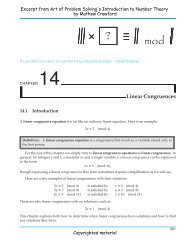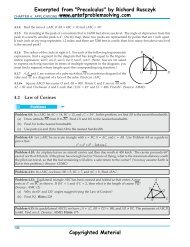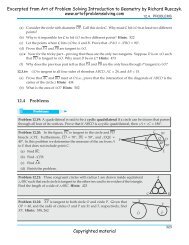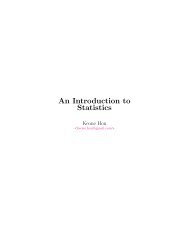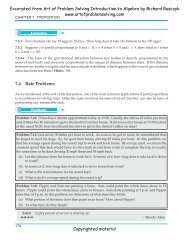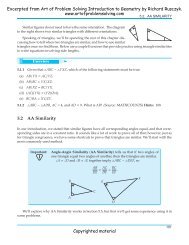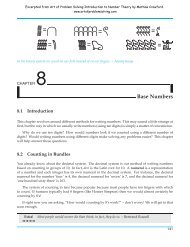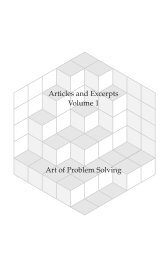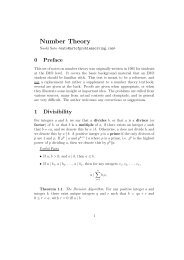Kitchen Table Math Book 1 (ver 2) - Art of Problem Solving
Kitchen Table Math Book 1 (ver 2) - Art of Problem Solving
Kitchen Table Math Book 1 (ver 2) - Art of Problem Solving
Create successful ePaper yourself
Turn your PDF publications into a flip-book with our unique Google optimized e-Paper software.
Excerpted from Dr. Wright's <strong>Kitchen</strong> <strong>Table</strong> <strong>Math</strong> <strong>Book</strong> 1 by Chris Wright<br />
www.DrWrights<strong>Kitchen</strong><strong>Table</strong><strong>Math</strong>.com<br />
CHAPTER1<br />
Quantities, Numbers, & Counting<br />
It all starts with quantities . . .<br />
A child starts his trip into mathematics by learning to identify<br />
quantities <strong>of</strong> objects. Children are essentially born with the ability to<br />
distinguish small quantities <strong>of</strong> one, two, or three objects directly by<br />
sight.<br />
There is an important difference between working with quantities<br />
<strong>of</strong> objects and working with the associated numbers. It is one thing<br />
for a child to see that when two apples are put with three apples that<br />
there is a collection <strong>of</strong> five apples, and quite another to understand<br />
that when the number two is added to three the answer is five.<br />
If you ask a child entering kindergarten to add 5 + 2, it is not<br />
unusual for a child <strong>of</strong> that age to do this by thinking <strong>of</strong> five things,<br />
perhaps fingers, and then putting two more <strong>of</strong> the same thing with<br />
them. That is, the child understands how to do the adding with<br />
quantities, and has not yet learned to work directly with numbers.<br />
This is perfectly fine, and is just part <strong>of</strong> the process all children go<br />
through in learning mathematics.<br />
Copyrighted Material (c) Chris Wright<br />
1
Excerpted from Dr. Wright's <strong>Kitchen</strong> <strong>Table</strong> <strong>Math</strong> <strong>Book</strong> 1 by Chris Wright<br />
www.DrWrights<strong>Kitchen</strong><strong>Table</strong><strong>Math</strong>.com<br />
CHAPTER 1. QUANTITIES, NUMBERS, & COUNTING<br />
Basic number understanding,<br />
identification, and counting are<br />
where e<strong>ver</strong>ything starts for you as<br />
a teacher. Naming the quantity<br />
<strong>of</strong> things and counting things out<br />
in front <strong>of</strong> your child can start at<br />
any age. This practice helps lay<br />
the groundwork for number familiarity<br />
and acceptance <strong>of</strong> numbers<br />
as part <strong>of</strong> the normal day to<br />
day world.<br />
Apply counting out loud to<br />
the simple things you see in the<br />
world, and have your child apply<br />
it doing e<strong>ver</strong>yday things. You can count shoes going on feet, vegetables<br />
being cut in the kitchen, food being placed on a plate, steps being<br />
climbed to get upstairs, nails being hammered into a board, red cars<br />
being passed on the road, and so on.<br />
Avoid having your child<br />
simply memorize the sequence<br />
<strong>of</strong> numbers as they are counted<br />
out. It may be impressive to<br />
friends and relatives that your<br />
child can count to 10 at a <strong>ver</strong>y<br />
early age, but it serves no good<br />
if your child is only parroting<br />
a sequence <strong>of</strong> meaningless<br />
words.<br />
While learning the numbers, it helps to compare the relative sizes<br />
<strong>of</strong> numbers. It is <strong>ver</strong>y easy to ask additional questions, such as who<br />
has more <strong>of</strong> something, or who is winning or losing, or how much<br />
one person or team is ahead or behind in some game.<br />
When doing comparisons, compare collections <strong>of</strong> objects where<br />
the objects are essentially identical. Little children <strong>of</strong>ten get confused<br />
between the concepts <strong>of</strong> quantity (how many) and size (how much<br />
length, area or volume), so you need to be a bit careful.<br />
2<br />
For example, if one person has a single new long pencil and the<br />
Copyrighted Material (c) Chris Wright
Excerpted from Dr. Wright's <strong>Kitchen</strong> <strong>Table</strong> <strong>Math</strong> <strong>Book</strong> 1 by Chris Wright<br />
www.DrWrights<strong>Kitchen</strong><strong>Table</strong><strong>Math</strong>.com<br />
other person has two well-used short pencils, little children are <strong>ver</strong>y<br />
tempted (quite reasonably) to say that the single pencil represents<br />
more pencils.<br />
Two invaluable visual aids at this stage <strong>of</strong> a child’s developing<br />
quantity and number understanding are a number chart (usually from<br />
1 to 100) and a number line.<br />
1 2 3 4 5 6 7 8 9 10<br />
11 12 13 14 15 16 17 18 19 20<br />
21 22 23 24 25 26 27 28 29 30<br />
31 32 33 34 35 36 37 38 39 40<br />
41 42 43 44 45 46 47 48 49 50<br />
51 52 53 54 55 56 57 58 59 60<br />
61 62 63 64 65 66 67 68 69 70<br />
71 72 73 74 75 76 77 78 79 80<br />
81 82 83 84 85 86 87 88 89 90<br />
91 92 93 94 95 96 97 98 99 100<br />
A number line is particularly useful in discussions comparing sizes<br />
<strong>of</strong> numbers. Your child will learn to associate being larger with being<br />
farther to the right on the number line, and being smaller with being<br />
farther to the left.<br />
0 1 2 3 4 5 6 7 8 9 10<br />
Copyrighted Material (c) Chris Wright<br />
3
Excerpted from Dr. Wright's <strong>Kitchen</strong> <strong>Table</strong> <strong>Math</strong> <strong>Book</strong> 1 by Chris Wright<br />
www.DrWrights<strong>Kitchen</strong><strong>Table</strong><strong>Math</strong>.com<br />
CHAPTER 1. QUANTITIES, NUMBERS, & COUNTING<br />
Number strips are another extremely helpful manipulative for<br />
learning the relationship between sizes and numbers. They are also<br />
helpful for learning addition and subtraction, and for developing a<br />
feeling for the numbers on a number line. There is a description for<br />
making these strips in Section 14.2: Number strips in the Manipulatives<br />
Chapter.<br />
As your child is able to count up to 6, 10, or 20, you can start<br />
playing some traditional games together. Games such as Parcheesi,<br />
Sorry, Dominoes, and Chutes and Ladders can be a lot <strong>of</strong> fun, and <strong>of</strong><br />
course they provide great practice. For games that involve two dice,<br />
such as Parcheesi, if your child does not feel comfortable with all <strong>of</strong><br />
the adding involved, then just count all <strong>of</strong> the dots on the two dice.<br />
Some <strong>of</strong> these games can be played with almost no counting whatsoe<strong>ver</strong>.<br />
For example, if the game involves rolling one die, then your<br />
child can move his game piece one place forward for each dot showing<br />
on the die. One game <strong>of</strong> this type is Mancala. This game involves<br />
moving small quantities <strong>of</strong> beads, but no counting is needed. It is described<br />
further in the section Mancala in Chapter 15: Learning Games<br />
and Activities<br />
4<br />
Copyrighted Material (c) Chris Wright
Excerpted from Dr. Wright's <strong>Kitchen</strong> <strong>Table</strong> <strong>Math</strong> <strong>Book</strong> 1 by Chris Wright<br />
www.DrWrights<strong>Kitchen</strong><strong>Table</strong><strong>Math</strong>.com<br />
1.1 A lot to learn<br />
Your child has more to learn than you may realize.<br />
1.1. A LOT TO LEARN<br />
Developmental steps There are many developmental steps that your<br />
child must go through before being completely ready to count<br />
and understand what it means.<br />
1 to 1 principle When counting objects, a single number is associated<br />
with each single object in the group.<br />
Ordered numbers principle The numbers used for counting<br />
must be used in a standard, fixed order. That is, counting<br />
is done 1, 2, 3, 4, and not 1, 5, 2, 4.<br />
Last number principle When counting a group <strong>of</strong> objects, the<br />
number associated with the last item counted is the number<br />
<strong>of</strong> objects in the group. It is one thing to associate one<br />
number with each item counted, it is another to realize that<br />
the last number used is the total number <strong>of</strong> objects.<br />
Uni<strong>ver</strong>sal principle Counting can be applied to any group <strong>of</strong><br />
objects, independent <strong>of</strong> the type <strong>of</strong> objects they are. Counting<br />
can be used with fingers, apples, people, cars, or any<br />
other collection <strong>of</strong> things.<br />
Unordered objects principle The objects in a group may be<br />
counted in any order, and the count will always be the<br />
same. If you have a red, a green, and a blue ball, you will<br />
count three balls whether the first ball counted is the red<br />
one, the green one, or the blue one.<br />
Most children will work through these developmental steps<br />
somewhere between the ages <strong>of</strong> 2 and 3.<br />
These are not things you can teach your child by explaining<br />
them. What you can do is count in front <strong>of</strong> your child, and with<br />
your child, whene<strong>ver</strong> the possibility presents itself. Give your<br />
child lots <strong>of</strong> opportunities to develop these principles internally.<br />
Ultimately, you must wait for your child to be ready.<br />
Copyrighted Material (c) Chris Wright<br />
5
Excerpted from Dr. Wright's <strong>Kitchen</strong> <strong>Table</strong> <strong>Math</strong> <strong>Book</strong> 1 by Chris Wright<br />
www.DrWrights<strong>Kitchen</strong><strong>Table</strong><strong>Math</strong>.com<br />
CHAPTER 1. QUANTITIES, NUMBERS, & COUNTING<br />
So much to learn Once your child is able to count, it is important<br />
that you understand just how much there is for your child to<br />
learn. Your child will be learning to say, hear, write, and read<br />
the names and symbols for the different numbers, as well as<br />
learning to recognize and associate the quantities linked with<br />
those numbers.<br />
6<br />
To give you a taste <strong>of</strong> how much effort is involved for a child<br />
learning new symbols and how to use them, educator Rick Garlikov<br />
proposes that we invent ten new names for the digits, say<br />
“a” through “j” in place <strong>of</strong> 0 through 9.<br />
Now try to count by h’s to the number ha (count by 7’s to 70).<br />
h, be, cb, ci, d f, ec, ej, f g, gd, ha<br />
7, 14, 21, 28, 35, 42, 49, 56, 63, 70<br />
As another example, figure out that db + ij = bca. Although it is<br />
the same thing, notice how much harder this is for us than the<br />
usual calculation 31 + 89 = 120.<br />
It may be automatic for us to see 1+9 and think 10, but look how<br />
much harder it becomes when you see the same thing written<br />
as b + j = ba. There is a lot that is easy for us that your child has<br />
to work for.<br />
Copyrighted Material (c) Chris Wright



